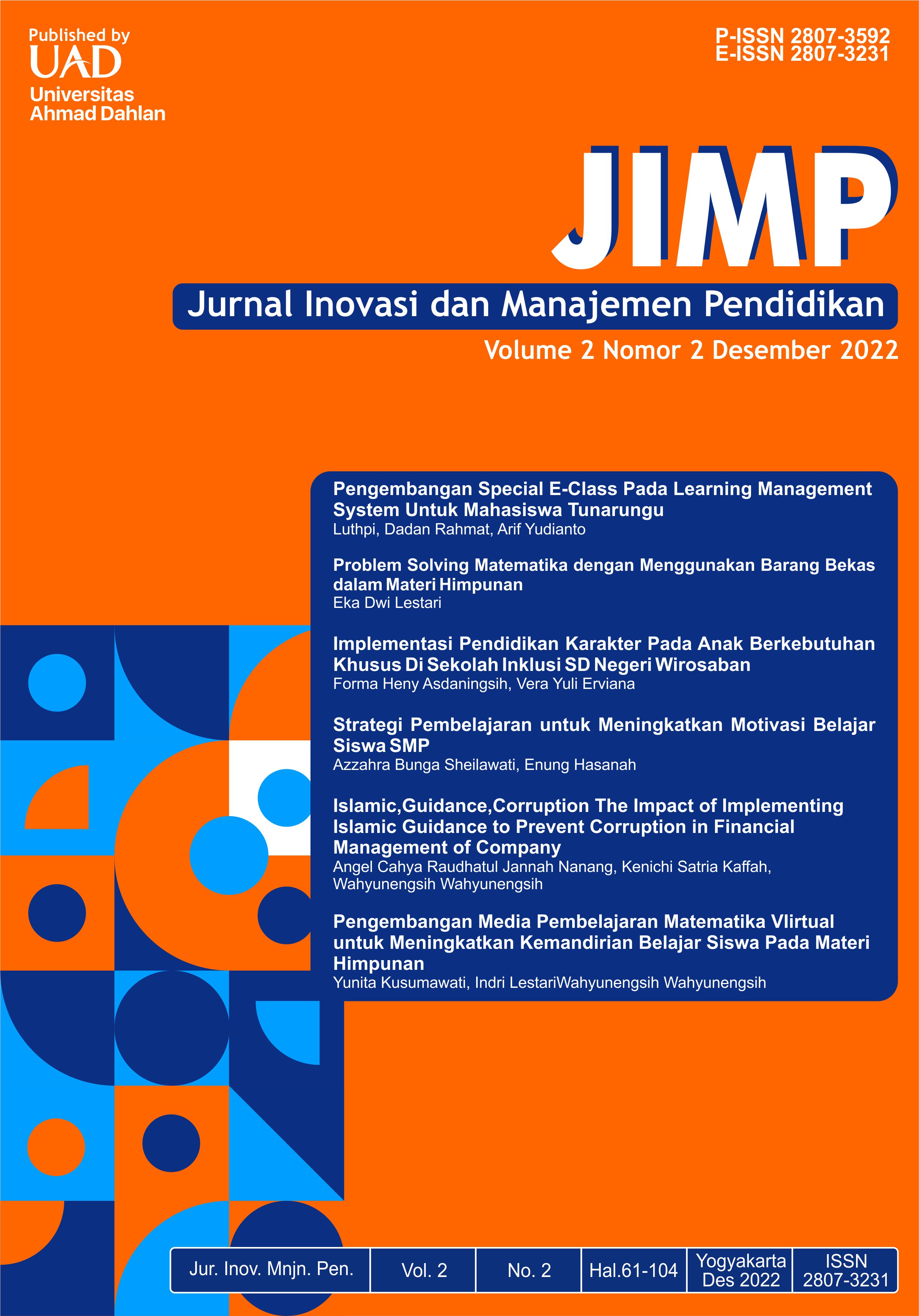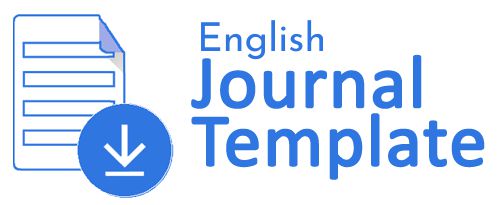Pengembangan Media Pembelajaran Matematika VIirtual untuk Meningkatkan Kemandirian Belajar Siswa Pada Materi Himpunan
DOI:
https://doi.org/10.12928/jimp.v2i2.4986Keywords:
Himpunan, Kemandirian Belajar, Pembelajaran Matematika VirtualAbstract
Penelitian ini bertujuan untuk mengetahui kelayakan produk media pembelajaran matematika virtual pada materi himpunan dan untuk mengetahui terdapatnya peningkatan kemandirian belajar siswa sebelum dan sesudah uji coba produk. Penelitian ini dilakukan sebagai pengembangan media pembelajaran virtual pada siswa kelas VII  untuk mempelajari materi himpunan. Produk yang dikembangkan yaitu dalam bentuk pembelajaran virtual menggunakan platform Gnomio.com sebagai akses pada pembelajaran virtual. Metode yang digunakan pada penelitian ini yaitu metode penelitian dan pengembangan. Pada hasil penelitian yang diperoleh, dapat disimpulkan bahwa media pembelajaran matematika virtual pada materi himpunan untuk kelas VII memperoleh tingkat kelayakan sebesar 79% dari uji Ahli Materi dan uji Ahli Media sebesar 91%  sehingga produk layak digunakan oleh siswa untuk mempelajari materi himpunan dan terdapat peningkatan kemandirian belajar siswa sebelum dan sesudah uji coba produk dengan gain sebesar 0,6 pada uji skala terbatas dan 0,6 pada uji lapangan.
References
Afriani, D. W. (2018). Efektifitas Model Pembelajaran Quantum Teaching dengan Media POPTRIKS dalam Pembelajaran Matematika (Doctoral dissertation, Universitas Muhammadiyah Surabaya). [Online]. Tersedia: http://repository.um-surabaya.ac.id/3508/.
Apriansyah, M. F., & Pujiastuti, H. (2020). Pengembangan Bahan Ajar Matematika berbasis Virtual Learning dengan Gnomio. Jurnal Pendidikan Matematika [Online], 11(2), 179-188. Tersedia: https://www.neliti.com/publications/317679/pengembangan-bahan-ajar-matematika-berbasis-virtual-learning-dengan-Gnomio.
Arikunto, S. (2013). Prosedur Penelitian: Suatu Pendekatan Praktik. Jakarta: Rineka Cipta.
Bahar, A. (201). AHZAA.net Media Info Belajar: Mencoba Moodle, Learning Management System (LMS) Terbaik untuk Pembelajaran Kelas Anda [Online]. Tersedia: https://www.ahzaa.net/2019/09/mencoba-moodle-learning-management.html.
Gunawan, G., Suranti, N. M. Y., & Fathoroni, F. (2020). Variations of models and learning platforms for prospective teachers during the COVID-19 pandemic period. Indonesian Journal of Teacher Education [Online], 1(2), 61-70. Tersedia: https://journal.publication-center.com/index.php/ijte/article/view/95.
Hake-Richard, R. (1998). “Interactive-Engagement Methods in Introductory Mechanics Coursesâ€. Journal of Physics Education Research [Online]. 66, 1-2. Tersedia: https://www.researchgate.net/publication/228710512_Interactive-Engagement_Versus_Traditional_Methods_A_Six-Thousand-Student_Survey_of_Mechanics_Test_Data_for_Introductory_Physics_Courses.
Herliandry, L. D., Nurhasanah, N., Suban, M. E., & Kuswanto, H. (2020). Pembelajaran pada masa pandemi covid-19. JTP-Jurnal Teknologi Pendidikan [Online], vol 22(1), 65-70. Tersedia: http://journal.unj.ac.id/unj/index.php/jtp/article/view/15286.
Kemendikbud. (2020). Pedoman Penyelenggaraan Belajar Dari Rumah Dalam Masa Darurat Penyebaran Covid-19 [Online], Tersedia: https://www.kemdikbud.go.id/main/blog/2020/05/kemendikbud-terbitkan-pedoman-penyelenggaraan-belajar-dari-rumah.
Khatimah, H., Utami, S. D., & Mursali, S. (2018). Pengembangan Lks Berbasis Kearifan Lokal untuk Peningkatan Keterampilan Penyelesaian Masalah Siswa. Bioscientist: Jurnal Ilmiah Biologi [Online], 6(2), 173-181. Tersedia: https://e-journal.undikma.ac.id/index.php/bioscientist/article/view/2458.
Meltzere, D. E (2002). The relationship between Mathematics Preparation and Conceptual Learning Gain in Physics : A “Hidden Variable’ in Diagnostics Pretest Score. American Journal of Physics [Online]. Tersedia : http://www.physicseducation.net/docs/AJP-Dec-2002-Vol.70-1259-1268.pdf.
Pemerintahan Indonesia. 2003. Undang-Undang Nomor 20 Tahun 2003 tentang Sistem Pendidikan Nasional. Lembaran RI Tahun 2003, No 78, Tambahan Lembaran Negara RI No 4301 . Jakarta: Sekertariat Negara.
Pratiwi, R. A., Hendrayana, A., & Ihsanudin, I. (2020). Pengembangan Kelas Virtual dengan Gnomio Dalam Kecakapan Komunikasi Matematis Siswa Topik Transformasi. Jurnal Cendekia: Jurnal Pendidikan Matematika [Online], 4(1), 380-395. Tersedia: https://www.j-cup.org/index.php/cendekia/article/view/199.
Septiani, E. (2018, October). Pemanfaatan E-Learning dalam pembelajaran bahasa dan sastra Indonesia. In Pesona: Pekan Seminar Nasional Pendidikan Bahasa dan Sastra Indonesia [Online]. (Vol. 1, No. 1, pp. 92-98). Tersedia: https://media.neliti.com/media/publications/340200-e-learning-berbasis-moodle-sebagai-media-6ea6c368.pdf.
Sudiana, R., Fatah, A., & Khaerunnisa, E. (2017). Kemandirian belajar mahasiswa melalui pembelajaran berbasis virtual class. JPPM (Jurnal Penelitian dan Pembelajaran Matematika) [Online], 10(1). Tersedia: https://jurnal.untirta.ac.id/index.php/JPPM/article/view/1292.
Sugiyono. (2017) Metode Penelitian Kuantitatif Kualitatif dan R&D. Bandung : Alfabeta
Suherman, Turmudi, dkk. 2003. Strategi Pembelajaran Matematika Kontemporer. Bandung: JICA
Widoyoko, E. P. (2017). Teknik Penyusunan Instrumen Penelitian. Yogyakarta: Pustaka Pelajar.
Yuliati, Y. (2017). Literasi sains dalam pembelajaran IPA. Jurnal cakrawala pendas [Online], 3(2). Tersedia: https://core.ac.uk/download/pdf/228882834.pdf .
Downloads
Published
How to Cite
Issue
Section
License
Copyright (c) 2022 Universitas Ahmad Dahlan

This work is licensed under a Creative Commons Attribution-ShareAlike 4.0 International License.
This article's copyright is transferred to Universitas Ahmad Dahlan (UAD) if and when the item is accepted for publication. The undersigned hereby transfers any rights in and to the paper including without limitation all copyrights to UAD. The undersigned hereby represents and warrants that the article is original and that he/she is the author of the paper, except for material identified as to its source, with permission notices from the copyright owners where required. The undersigned represents that he/she has the power and authority to make and execute this assignment.
We declare that:
This paper has not been published in the same form elsewhere.
It will not be submitted anywhere else for publication before acceptance/rejection by this Journal.
Copyright permission is obtained for materials published elsewhere and which require this permission for reproduction.
Furthermore, I/We hereby transfer the unlimited rights of publication of the above-mentioned paper in whole to UAD. The copyright transfer covers the exclusive right to reproduce and distribute the article, including reprints, translations, photographic reproductions, microform, electronic form (offline, online), or any other reproductions of similar nature.
The corresponding author signs for and accepts responsibility for releasing this material on behalf of any co-authors. This agreement is to be signed by at least one of the authors who have obtained the co-author(s) assent where applicable. After submission of this agreement signed by the corresponding author, changes of authorship or in the order of the authors listed will not be accepted.
Retained Rights/Terms and Conditions
Authors retain all proprietary rights in any process, procedure, or article of manufacture described in the Work.
Authors may reproduce or authorize others to reproduce the Work or derivative works for the author's personal use or company use, provided that the source and the UAD copyright notice are indicated, the copies are not used in any way that implies UAD endorsement of a product or service of any employer, and the documents themselves are not offered for sale.
Although authors are permitted to re-use all or portions of the Work in other works, this does not include granting third-party requests for reprinting, republishing, or different types of re-use.







